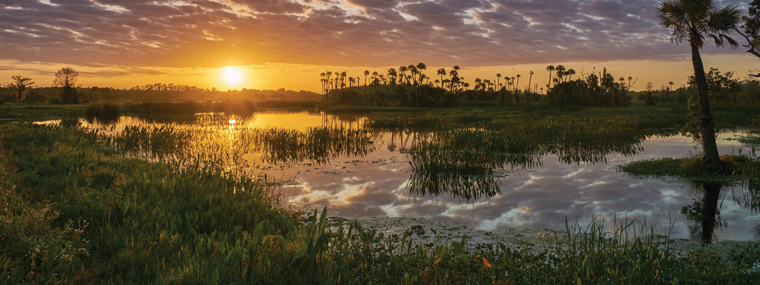
Q & A
Our Waterfront Land Is Falling into Lakes; Homes at Risk for Flooding
By Dustin Anderson / Published April 2020

Before you know it, Florida will be in the midst of its rainy season and under the inevitable threat of hurricanes. Now is the time for community associations to begin preparation. As we enter this period, it’s important to realize that you’re not alone, and your challenges are being experienced and addressed by associations throughout the state.
Here are some of the questions and answers we have received from clients and those seeking answers to a wide range of environmental issues.
Our community has numerous lakes and canals. We’re seeing quite a bit of shoreline erosion that is eating away at backyards and easements. Why is this happening?
First of all, don’t worry, because there are solutions. Keep in mind that this erosion is inevitable because of constantly changing water levels due to heavy rains and then the dry season. This is happening because of constant water movement, which is pulling the sediment from the adjacent shoreline.
If our association doesn’t address these issues, what are the possible ramifications?
Inaction can result in expensive situations. With land literally disappearing into waterways, homes are at further risk of flooding. Exposed cable lines can lead to expensive repairs. Unstable land can result in serious injuries to homeowners and those operating heavy equipment, and it can cause injuries to homeowners who enjoy walking along their lakefront properties.
What can be done?
There are many solutions that address shoreline erosion. We regularly recommend the SOX Erosion Solutions™ line of products. Golf courses, municipalities, governmental agencies, and homeowners associations are using these systems because of their cost effectiveness and ease of installation.
It can be installed quickly, depending on the length of shoreline, and re-creates the original shoreline while reclaiming lost land. It also allows residents to once again enjoy the views and activities associated with having lakefront property. It is one of the most effective ways to restore shorelines, prevent future erosion, and safeguard wildlife habitats. In addition, the material serves as a natural filter, preventing pollutants from entering waterways.
The SOX products provide aesthetic value and are preferable to cement sea walls and rocks placed along shorelines.
We are seeing dead fish in our lakes and ponds. Why is this happening? What can be done?
Your waterways are probably experiencing poor water flow, resulting in water with low oxygen content. This can kill fish. The condition can be improved by installing fountains and other aeration systems. Depending on the age of the pond, over time sediment may build up excessively and prevent the pond from being healthy. This can be taken care of by dredging the excess “muck” from the waterbody.
We’ve heard that certain types of plants can actually cause damage to our waterways. What does this actually mean?
Aquatic plant management is one of the most significant aspects of lake and wetland maintenance. The Lake & Wetland team is certified to identify and rectify problems related to invasive plants, which are non-native vegetation that threatens the existence of natural plants. If not addressed, these invasive plants can overtake areas and actually result in wildlife habitat loss.
It seems as though our mosquito/midge populations are growing. Residents actually avoid leaving their homes to avoid these bothersome bugs. How can this problem be addressed?
Controlling the mosquito and midge population is essential for lakeside residents. This can be accomplished through the use of proven larvicides and the stocking of native mosquitofish.
We’ve heard that there are “natural” ways to eliminate algae and build-ups of organic sediment and sludge in our waterways. This is, of course, preferable to chemical solutions. Can you explain?
An alternative to applying algaecides is stocking waterways with grass carp. These fish are native to Asia and feed on algae. They can be farmed to be sterile, so when they are put into the lake to control the algae, the species will not overrun the other fish species.
Similar “natural” strategies can also be implemented to eliminate sediment that is common in many water bodies. This occurs as years of nutrients and organic matter enter the pond through runoff containing fertilizers, grass clippings, leaves, and animal waste. In many ponds, the largest contributor to pond sludge is dead algae, which accumulates annually. Our naturally occurring cultures efficiently digest pond bottom materials and lower the organic matter in the water column for cleaner water and higher oxygen levels.
Dustin Anderson
Field Operations Manager, Lake and Wetland Management
Dustin Anderson is Field Operations Manager with Lake and Wetland Management. Lake and Wetland Management is a full-service environmental resource management company that develops programs that protect and enhance environmental assets for golf courses, homeowners associations, and municipalities. The company has offices throughout Florida. For more information, visit www.lakeandwetland.com or call (855) 888-Lake.




